TL-WR840N V6.2 User Guide
- About This Guide
- Chapter 1 Get to Know About Your Router
- Chapter 2 Connect to the Internet
- Chapter 3 Log In to the Router
- Chapter 4 Configure the Router in Wireless Router Mode
- Chapter 5 Configure the Router in WISP Mode
- Chapter 6 Configure the Router in Access Point Mode
- Chapter 7 Configure the Router in Range Extender Mode
- FAQ
- Authentication
Q1.What should I do if I forget my wireless password?
The default wireless password is printed on the label of the router. If the password has been altered, please connect your computer to the router using an Ethernet cable and follow the steps below:
1.Visit http://tplinkwifi.net, and log in with the username and password you set for the router.
2.Go to Wireless > Wireless Security to retrieve or reset your wireless password.
Q2.What should I do if I forget my login password of the web management page?
The default username and password of the web management page are admin (in lowercase).
If you have altered the username and password:
1.Reset the router to its factory default settings.
2.Visit http://tplinkwifi.net, and enter admin (in lowercase) as both username and password to log in.
Note: You’ll need to reconfigure the router to surf the Internet once the router is reset, and please mark down your new password for future use.
Q3.What should I do if I cannot log in to the router’s web management page?
This can happen for a variety of reasons. Please try the methods below to log in again.
•Make sure your computerthe has connected to the router correctly and the corresponding LED light up.
•Make sure the IP address of your computer is configured as Obtain an IP address automatically and Obtain DNS server address automatically.
•Make sure you enter the correct IP address to log in: http://tplinkwifi.net or 192.168.0.1.
•Check your computer’s settings:
1 )Go to Start > Control Panel > Network and Internet, and click View network status and tasks.
2 )Click Internet Options on the bottom left.
3 )Click Connections and select Never dial a connection.

4 )Click LAN settings and deselect the following three options, and click OK.
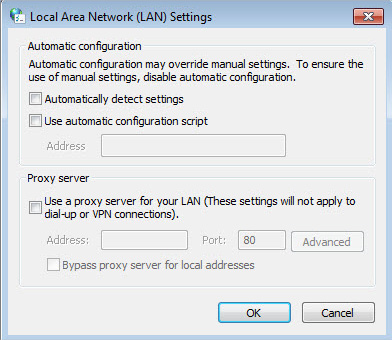
5 )Go to Advanced > Restore advanced settings, and click OK.
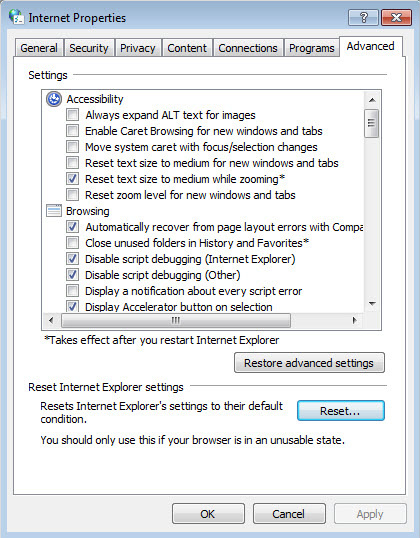
•Use another web browser or computer to log in again.
•Reset the router to factory default settings and try again. If the login still fails, please contact the technical support.
Note: You’ll need to reconfigure the router to surf the internet once the router is reset.
Q4.What should I do if I cannot access the internet even though the configuration is finished?
1.Visit http://tplinkwifi.net, and log in to with the username and password you set for the router.
2.Go to Status to check WAN status:
If IP Address is a valid one, please try the methods below and try again:
•Your computer might not recognize any DNS server addresses, please manually configure DNS server.
1 )Go to DHCP.
2 )Enter 8.8.8.8 as Primary DNS, and click Save.
Tips: 8.8.8.8 is a safe and public DNS server operated by Google.
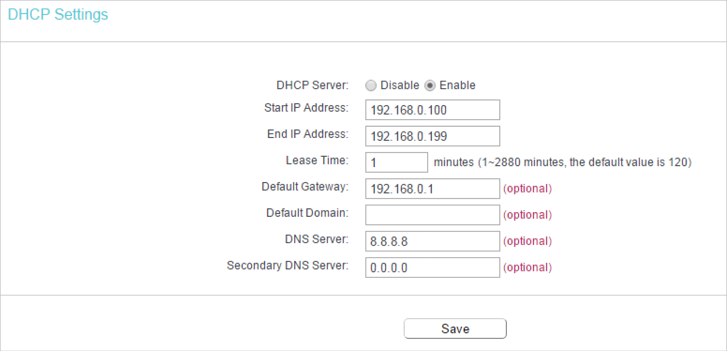
•Restart the modem and the router.
1 )Power off your modem and the router, and leave them off for 1 minute.
2 )Power on your modem first, and wait about 2 minutes.
3 )Power on the router, and wait another 1 or 2 minutes and check the Internet access.
•Reset the router to factory default settings and reconfigure the router.
•Upgrade the firmware of the router.
•Check the TCP/IP settings on the particular device if all other devices can get internet from the router.
If the IP Address is 0.0.0.0, please try the methods below and try again:
•Make sure the physical connection between the router and the modem is proper.
•Clone the MAC address of your computer.
1 )Visit http://tplinkwifi.net, and log in with the username and password you set for the router.
2 )Go to Network > MAC Clone, select Clone MAC Address and click Save.

Tips:
•Some ISP will register the MAC address of your computer when you access the Internet for the first time through their Cable modem, if you add a router into your network to share your Internet connection, the ISP will not accept it as the MAC address is changed, so we need to clone your computer’s MAC address to the router.
•The MAC addresses of a computer in wired connection and wireless connection are different.
•Modify the LAN IP address of the router.
Note:
Most TP-Link routers use 192.168.0.1/192.168.1.1 as their default LAN IP address, it may conflict with the IP range of your existent ADSL modem/router. If so, the router is not able to communicate with your modem and cause you can’t access the Internet. To resolve this problem, we need to change the LAN IP address of the router to avoid such conflict, for example, 192.168.2.1.
1 )Visit http://tplinkwifi.net, and log in with the username and password you set for the router.
2 )Go to Network > LAN.
3 )Modify the LAN IP address as the follow picture shows. Here we take 192.168.2.1 as an example.
4 )Click Save.
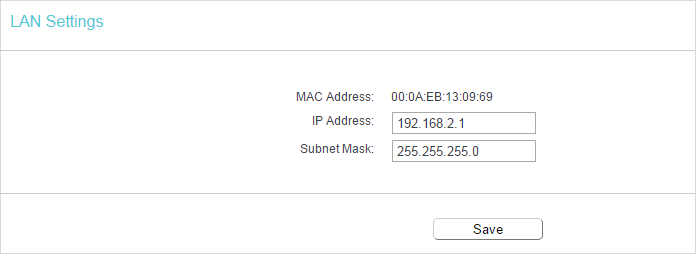
•Restart the modem and the router.
1 )Power off your modem and the router, and leave them off for 1 minute.
2 )Power on your modem first, and wait about 2 minutes.
3 )Power on the router, and wait another 1 or 2 minutes and check the internet access.
•Double check the Internet Connection Type.
1 )Confirm your Internet Connection Type, which can be learned from the ISP.
2 )Visit http://tplinkwifi.net, and log in with the username and password you set for the router.
3 )Go to Network > WAN.
4 )Select your WAN Connection Type and fill in other parameters.
5 )Click Save.
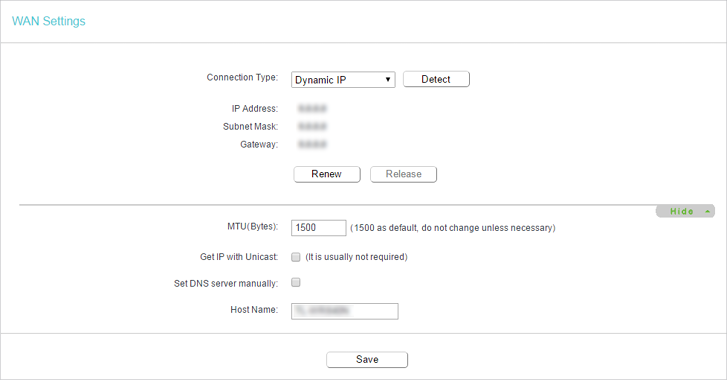
6 )Restart the modem and the router.
•Please upgrade the firmware of the router.
If you’ve tried every method above but cannot access the internet, please contact the technical support.
Q5.What should I do if I cannot find my wireless network or I cannot connect to the wireless network?
If you fail to find any wireless network, please follow the steps below:
•Make sure the wireless function of your device is enabled if you’re using a laptop with a built-in wireless adapter. You can refer to the relevant document or contact the laptop manufacturer.
•Make sure the wireless adapter driver is installed successfully and the wireless adapter is enabled.
•On Windows 7
1 )If you see the message No connections are available, it is usually because the wireless function is disabled or blocked somehow.
2 )Clicking Troubleshoot and windows might be able to fix the problem by itself.
•On Windows XP
1 )If you see the message Windows cannot configure this wireless connection, this is usually because windows configuration utility is disabled or you are running another wireless configuration tool to connect the wireless.
2 )Exit the wireless configuration tool (the TP-Link Utility, for example).
3 )Select and right click My Computer on Desktop, and select Manage to open Computer Management window.
4 )Expand Services and Applications > Services, and find and locate Wireless Zero Configuration in the Services list on the right side.
5 )Right click Wireless Zero Configuration, and then select Properties.
6 )Change Startup type to Automatic, click Start and make sure the Service status is Started. And then click OK.
If you can find other wireless network except your own, please follow the steps below:
•Make sure your computer/device is still in the range of your router/modem. Move closer if it is currently too far away.
If you can find your wireless network but fail to connect, please follow the steps below:
•Authenticating problem/password mismatch:
1 )Sometimes you will be asked to type in a PIN number when you connect to the wireless network for the first time. This PIN number is different from the Wireless Password/Network Security Key. Usually you can only find it on the label of your router.
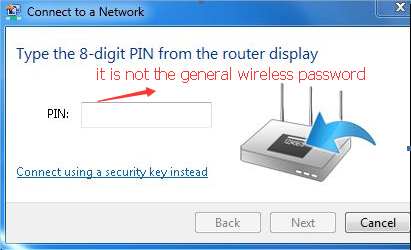
2 )If you cannot find the PIN or PIN failed, you may choose Connecting using a security key instead, and then type in the Wireless Password/Network Security Key.
3 )If it continues to show note of Network Security Key Mismatch, it is suggested to confirm the wireless password of your wireless router.
Note: Wireless Password/Network Security Key is case sensitive.
•Windows unable to connect to XXXX / Can not join this network / Taking longer than usual to connect to this network:
•Check the wireless signal strength of your network, if it is weak (1~3 bars), please move the router closer and try again.
•Change the wireless Channel of the router to 1,6,or 11 to reduce interference from other networks.
•Re-install or update the driver for your wireless adapter of the computer.